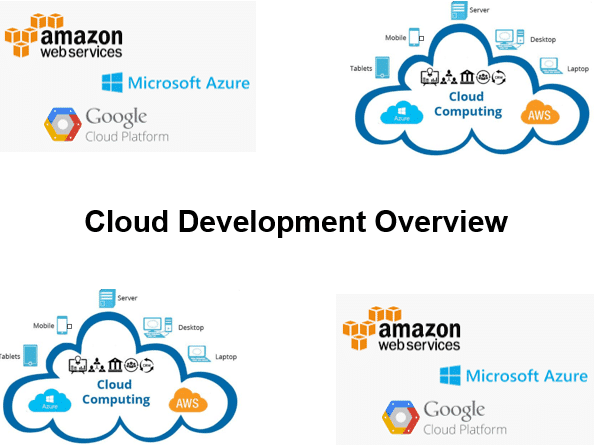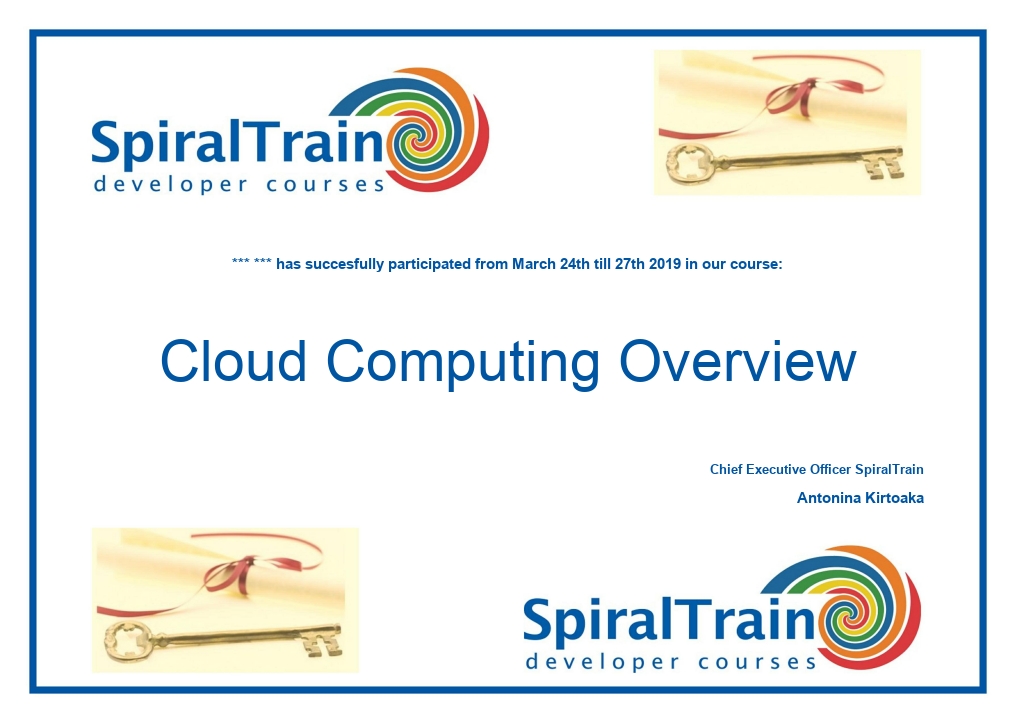-
Learning by doing
-
Trainers with practical experience
-
Classroom training
-
Detailed course material
-
Clear content description
-
Tailormade content possible
-
Training that proceeds
-
Small groups
In the course Cloud Computing from SpiralTrain the participants learn the fundamentals of Cloud Computing and why it is used by more and more organizations to meet their IT needs. Cloud Computing means a major change in the way we think about the IT infrastructure. Cloud Computing eliminates the need to make costs for the purchase of hardware and software and for setting up and managing your own on-site data centers. Many Cloud Computing services are provided as self-service on demand and at much less cost than an infrastructure in-house.
The course Cloud Computing starts with a discussion of the advantages of Cloud Computing such as less management costs, better scalability, up to date security and backup. The possibilities for virtualization and monitoring are also treated.
Furthermore attention is paid to the different types such as public clouds that are managed by external cloud providers and private clouds that are specifically intended for one company. Hybrid and community clouds are also covered.
Part of the program of the course Cloud Computing Overview is also what is called the Cloud Computing Stack. Cloud Services come in four main categories: Infrastructure as a Service (IaaS), Platform as a Service (PaaS), Serverless and Software as a Service (SaaS).
Various Cloud Providers such as Amazon Web Services, Microsoft Azure and Google Cloud are reviewed. Their differences are explained as well as how you deploy applications on them.
Attention is also paid to the use of lightweight container images that contain applications with all dependencies and that can be started quickly. The difference between containers and virtual machines is treated and both Docker and OpenShift containers are covered.
Finally container orchestration with Docker Swarm and Kubernetes is discussed and the use of ADC Controllers with Load Balancing and Multiplexing is explained.
The course Cloud Computing Overview is aimed at everyone who wants to use Cloud Computing and requires a detailed understanding of the relevant technologies.
Experience in modern IT technologies and preferably development methodologies is required.
The subject matter is treated on the basis of presentation slides. Demos are used to clarify the theory. During the course theory and exercises are interchanged. The course material is in English. The course times are from 9.30 up and to 16.30.
Participants receive an official certificate of participation in Cloud Computing Overview after successful completion of the course.

Module 1 : Cloud Computing Intro |
Module 2 : Type of Clouds |
Module 3 : Cloud Providers |
|
What is Cloud Computing? Cloud Computing Concepts Virtualization Principles Cloud Features Elasticity and On-demand Usage Measurement Benefits and Riscs Distributed storage Concurrent computing Redundancy and Security Virtual Servers Monitoring Application Health |
Platforms en Cloud Services Cloud Resource Administrator Cloud Service Owner Cloud Delivery Models Software as a Service (SaaS) Platform as a Service (PaaS) Infrastructure as a Service (IaaS) Combining Delivery Models Public and Private Cloud Hybrid and Community Cloud Cloud Balancing Cloud Bursting Architectures |
Amazon Web Services EC2 Instances AWS CLI Tools Amazon SimpleDB Services Deploying AWS Applications Microsoft Azure Configuring Services Fabric Controller Google Cloud Platform Using Google API's Google App Engine Cloud Storage |
Module 4 : Containerization |
Module 5 : Container Orchestration |
Module 6 : ADC Controllers |
|
Intro Container Technology Role of Containers Creating Containerized Services Managing Containers Managing Container Images Creating Custom Images Container Hosting Logical Pod Containers Containerization vs Virtualization OpenShift versus Docker Docker Details OpenShift Details Deploying Container Apps |
Docker Swarm Filtering and Scheduling Highly Available Infrastructure High Availability HA Discovery Service HA Swarm Managers Standard Constraints Custom Constraints Install and Configure Kubernetes Use Docker Client Stateless Apps on Kubernetes Statefull Apps on Kubernetes Serverless Computing |
What is an ADC? Load Balancing User Data Offloading of Secure Sockets Layer Offloading Firewall Functions Types of LoadBalancing Ensuring Server Health Monitoring DNS and HTTP Multiplexing Contributing in Cybersecurity Firewall Protection Facilities Preventing DDOS Preventing Vendor Lock In Future Improvements |
